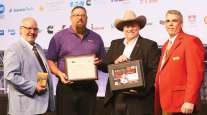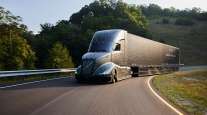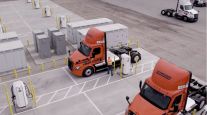Managing Editor, Features and Multimedia
NACFE, RMI Release New Report on SuperTruck 2 Findings
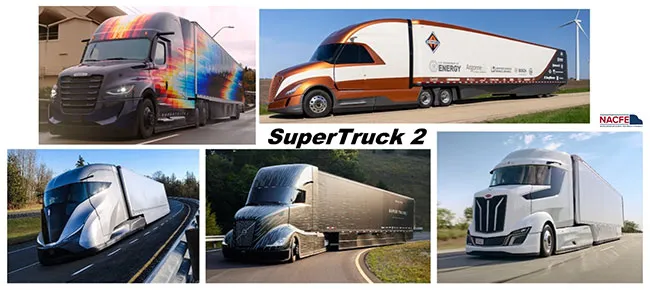
Daimler Truck North America, Volvo Trucks, Navistar, Paccar Inc. and a joint Peterbilt and Cummins Inc. team participated in the SuperTruck 2 program. (North American Council for Freight Efficiency)
[Stay on top of transportation news: Get TTNews in your inbox.]
NEW ORLEANS — The North American Council for Freight Efficiency and RMI have released a new report assessing the commercial vehicle technologies investigated and demonstrated by truck makers as part of the U.S. Department of Energy’s SuperTruck 2 program.
The NACFE report, titled “SuperTruck 2: Empowering Future Trucks,” found that the technologies and innovations tested during this project not only highlight the potential for improving the efficiency of diesel-powered trucks but also help set the stage for zero-emission commercial vehicles.
NACFE introduced the report March 3 at the 2024 Technology & Maintenance Council Annual Meeting & Transportation Technology Exhibition.
SuperTruck 2, launched by the Department of Energy in 2016 as a follow-up to the original SuperTruck program, challenged Class 8 truck manufacturers to achieve a 100% increase in freight-ton efficiency compared with a 2009 baseline.
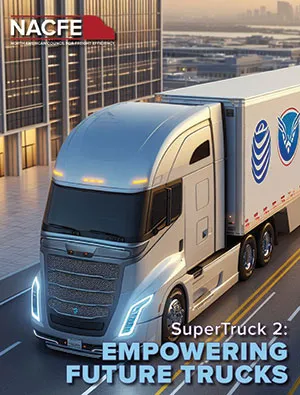
Through a combination of public and private funding, teams from Daimler Truck North America, Volvo Trucks, Navistar, Paccar Inc. and a joint Peterbilt and Cummins Inc. team designed and built demonstrator trucks aimed at raising the bar for efficiency in longhaul trucking.
“SuperTruck 2 had the five teams looking at the entire tractor-trailer as a single unit, which yielded significantly improved performance benefits versus a more piecemeal approach,” said Mike Roeth, NACFE’s executive director.
The SuperTruck 2 demonstrator trucks incorporated a wide range of technologies to boost efficiency, including further improvements in aerodynamics, lightweighting, lift axles and improved tandems, “mild” and full hybridization, as well as innovative cab configurations, including a center position for the driver’s seat.
While some of the technologies demonstrated on the SuperTruck 1 and 2 vehicles have not yet been deemed viable for commercialization, other SuperTruck innovations already have influenced the development of Class 8 production models, sometimes in subtle ways, such as more aerodynamic vehicle designs, Roeth said.
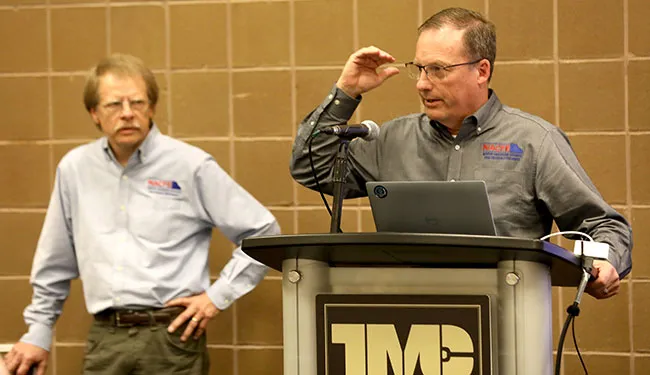
Mike Roeth (right), NACFE executive director, and Rick Mihelic, NACFE director of emerging technologies, discuss the findings from the SuperTruck 2 project at TMC. (John Sommers II for Transport Topics)
“The SuperTruck program has delivered some really good production-intent features that are in trucks today, helping to save money and save emissions,” he said.
With demonstration trucks attaining as much as 16 miles per gallon, the SuperTruck 2 program illustrated that significant opportunities remain for increasing the efficiency of diesel-powered trucks but also highlighted the complexity required to realize those gains, the NACFE report concluded.
Get the inside scoop on ATA's Technology & Maintenance Council Annual Meeting March 4-7 in New Orleans. Tune in above or by going to RoadSigns.ttnews.com.
The report also makes the case that the SuperTruck projects have empowered designers and engineers to innovate and pursue ideas that might not be possible within normal product development cycles.
In addition, NACFE concluded that many of the tractor-trailer efficiency gains achieved for trucks with internal combustion engines are applicable to other powertrains as well, including zero-emission trucks.
“The technologies deployed on the SuperTruck 2 vehicles can be used on alternative-fueled trucks to increase both range and freight capacity,” said Rick Mihelic, NACFE’s director of emerging technologies.
One technology approach that has not gained favor through the SuperTruck 2 projects, in NACFE’s view, is waste-heat recovery. These systems are designed to capture and repurpose energy that otherwise would have been lost during the diesel combustion process, but they also add complexity and cost and may not be required to meet tighter greenhouse gas emission standards.
The report is available online at: nacfe.org/research/thought-leadership.
Want more news? Listen to today's daily briefing below or go here for more info:




